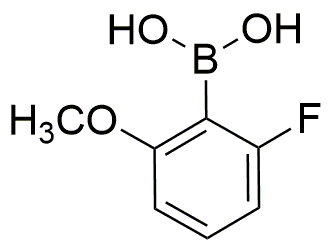2-Fluoro-6-methoxyphenylboronic acid is widely utilized in research focused on:
- Pharmaceutical Development: This compound serves as a key intermediate in the synthesis of various pharmaceuticals, particularly in the development of drugs targeting cancer and other diseases. Its unique structural features enhance the efficacy of drug candidates.
- Organic Synthesis: It is employed in Suzuki coupling reactions, which are crucial for forming carbon-carbon bonds in organic synthesis. This application is vital for creating complex molecules in the chemical industry.
- Material Science: The compound is used in the development of advanced materials, including polymers and nanomaterials, due to its ability to modify surface properties and enhance material performance.
- Bioconjugation: In biochemistry, it facilitates the attachment of biomolecules to surfaces or other molecules, which is essential for creating biosensors and drug delivery systems.
- Analytical Chemistry: It is utilized in the development of analytical methods for detecting and quantifying various substances, providing researchers with reliable tools for their studies.
General Information
Properties
Safety and Regulations
Applications
2-Fluoro-6-methoxyphenylboronic acid is widely utilized in research focused on:
- Pharmaceutical Development: This compound serves as a key intermediate in the synthesis of various pharmaceuticals, particularly in the development of drugs targeting cancer and other diseases. Its unique structural features enhance the efficacy of drug candidates.
- Organic Synthesis: It is employed in Suzuki coupling reactions, which are crucial for forming carbon-carbon bonds in organic synthesis. This application is vital for creating complex molecules in the chemical industry.
- Material Science: The compound is used in the development of advanced materials, including polymers and nanomaterials, due to its ability to modify surface properties and enhance material performance.
- Bioconjugation: In biochemistry, it facilitates the attachment of biomolecules to surfaces or other molecules, which is essential for creating biosensors and drug delivery systems.
- Analytical Chemistry: It is utilized in the development of analytical methods for detecting and quantifying various substances, providing researchers with reliable tools for their studies.
Documents
Safety Data Sheets (SDS)
The SDS provides comprehensive safety information on handling, storage, and disposal of the product.
Product Specification (PS)
The PS provides a comprehensive breakdown of the product’s properties, including chemical composition, physical state, purity, and storage requirements. It also details acceptable quality ranges and the product's intended applications.
Certificates of Analysis (COA)
Search for Certificates of Analysis (COA) by entering the products Lot Number. Lot and Batch Numbers can be found on a product’s label following the words ‘Lot’ or ‘Batch’.
Numéro de catalogue
Numéro de lot/série
Certificates Of Origin (COO)
This COO confirms the country where the product was manufactured, and also details the materials and components used in it and whether it is derived from natural, synthetic, or other specific sources. This certificate may be required for customs, trade, and regulatory compliance.
Numéro de catalogue
Numéro de lot/série
Safety Data Sheets (SDS)
The SDS provides comprehensive safety information on handling, storage, and disposal of the product.
DownloadProduct Specification (PS)
The PS provides a comprehensive breakdown of the product’s properties, including chemical composition, physical state, purity, and storage requirements. It also details acceptable quality ranges and the product's intended applications.
DownloadCertificates of Analysis (COA)
Search for Certificates of Analysis (COA) by entering the products Lot Number. Lot and Batch Numbers can be found on a product’s label following the words ‘Lot’ or ‘Batch’.
Numéro de catalogue
Numéro de lot/série
Certificates Of Origin (COO)
This COO confirms the country where the product was manufactured, and also details the materials and components used in it and whether it is derived from natural, synthetic, or other specific sources. This certificate may be required for customs, trade, and regulatory compliance.


